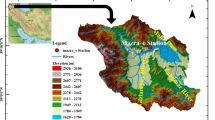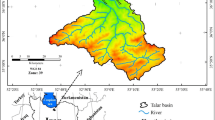Abstract
This paper evaluates the performance of three soft computing techniques, namely Gene-Expression Programming (GEP) (Zakaria et al 2010), Feed Forward Neural Networks (FFNN) (Ab Ghani et al 2011), and Adaptive Neuro-Fuzzy Inference System (ANFIS) in the prediction of total bed material load for three Malaysian rivers namely Kurau, Langat and Muda. The results of present study are very promising: FFNN (R 2 = 0.958, RMSE = 0.0698), ANFIS (R 2 = 0.648, RMSE = 6.654), and GEP (R 2 = 0.97, RMSE = 0.057), which support the use of these intelligent techniques in the prediction of sediment loads in tropical rivers.
Similar content being viewed by others
References
Ab Ghani A, Azamathulla H Md, Chang C K, Zakaria N A and Abu Hasan Z 2011 Prediction of total bed material load for rivers in Malaysia: A case study of Langat, Muda and Kurau rivers; J. Environ. Fluid Mechanics 11(3) 307–318.
Ab Ghani A, Zakaria N A, Abdullah R, Chang C K, Sinnakaudan S K and Mohd Sidek L 2003 Guidelines for field data collection and analysis of river sediment, Malaysia, Kuala Lumpur: Department of Irrigation and Drainage, 35p.
Altunkaynak A 2007 Forecasting surface water level fluctuations of Lake Van by Artificial Neural Networks; Water Resour. Manag. 21(2) 399–408.
Antar M, Elassiouti I and Allam M 2006 Rainfall-runoff modelling using artificial neural networks technique: A Blue Nile catchment case study; Hydrol. Process. 20(5) 1201–1216.
Aqil M, Kita I, Yano A and Nishiyama S 2007 Neural networks for real time catchment flow modelling and prediction; Water Resour. Manag. 21(10) 1781–1796.
Ariffin J, Ahmad Kamal N, Sa’adon M S, Taib M N, Abdul-Talib S, Ab Ghani A, Zakaria N A and Yahaya A S 2008 Sediment model for natural and man-made channels using general regression neural network; Journal of the Institution of Engineers, Malaysia 69(3) 44–58.
Aytek A and Kisi O 2008 A genetic programming approach to suspended sediment modeling; J. Hydrol. 351(3–4) 288–298.
Azamathulla H Md and Ab Ghani A 2010 Genetic programming to predict river pipeline scour; J. Pipeline Syst. Eng. Pract. 1(3) 127–132.
Azamathulla H Md, Chang C K, Ab Ghani A, Abu Hasan Z, and Zakaria N A 2009 An ANFIS-based approach for predicting the bed load for moderately-sized rivers; J. Hydro-environment Res. 3(1) 35–44.
Azamathulla H Md, Deo M C and Deolalikar P B 2005 Neural networks for estimation of scour downstream of a flip bucket; J. Hydraul. Eng. 131(10) 898–908.
Azamathulla H Md, Deo M C and Deolalikar P B 2008 Alternative neural networks to estimate the scour below spillways; Advances in Engineering Software 39(8) 689–698.
Chang C K, Ab Ghani A, Abdullah R and Zakaria N A 2008 Sediment transport modeling for Kulim river - A case study; J. Hydro-environment Res. 2(1) 47–59.
Chang C K, Ab Ghani A, Zakaria N A, Abu Hasan Z and Abdullah R 2005 Sediment transport equation assessment for selected rivers in Malaysia; Int. J. River Basin Manag. 3(3) 203–208.
Demuth H, Beale M and Hagan M 2007 Neural Network Toolbox 6, Users Guide; The MathWorks Inc., Natick, M.A.
Department of Irrigation and Drainage Malaysia (DID) 2009 Study on River Sand Mining Capacity in Malaysia; DID, Kuala Lumpur.
Dogan E, Yüksel I and Kisi O 2007 Estimation of total sediment load concentration obtained by experimental study using artificial neural networks; Environ. Fluid Mechanics 7(4) 271–288.
Dogan E, Tripathi S, Lyn D A and Govindaraju R S 2009 From flumes to rivers: Can sediment transport in natural alluvial channels be predicted from observations at the laboratory scale?; Water Resour. Res. 45(8) W08433.
Engelund F and Hansen E A 1967 Monograph on sediment transport in alluvial streams; Copenhagen, Denmark: Teknisk Forlag.
Ferreira C 2001a Gene expression programming in problem solving; 6th Online World Conference on Soft Computing in Industrial Applications (invited tutorial).
Ferreira C 2001b Gene expression programming: A new adaptive algorithm for solving problems; Complex Syst. 13(2) 87–129.
Firat M and Turan E 2010 Monthly river flow forecasting by an Adaptive Neuro-Fuzzy Inference System; Water Environ. J. 24(2) 116–125.
Guven A 2009 Linear genetic programming for time-series modelling of daily flow rate; J. Earth Syst. Sci. 118(2) 137–146.
Guven A and Aytek A 2009 A new approach for stage–discharge relationship: Gene-Expression Programming; J. Hydrol. Eng. 14(8) 812–820.
Kisi O 2005 Suspended sediment estimation using neuro-fuzzy and neural network approaches; Hydrol. Sci. 50(4) 683–696.
Kisi O 2007 Evapotranspiration modelling from climatic data using a neural computing technique; Hydrol. Process. 21(4) 1925–1934.
Kisi O, Karahan M E and Sen Z 2006 River suspended sediment modelling using a fuzzy logic approach; Hydrol. Process. 20(20) 4351–4362.
Kondolf G M, Smeltzer M and Kimball L 2001 Freshwater Gravel Mining and Dredging Issues; Washington Departments of Fish and Wildlife, Ecology, and Transportation, Olympia.
Koza J R 1992 Genetic programming: On the programming of computers by means of natural selection; A Bradford Book, MIT Press.
Liriano S L and Day R A 2001 Prediction of scour depth at culvert outlets using neural networks; J. Hydroinformatics 3(4) 231–238.
MATLAB 2007 Neural network tool box version 5.0. The Math-Works Inc., Matick, Mass.
Nagy H M, Watanabe K and Hirano M 2002 Estimation of sediment load concentration in rivers using artificial neural network model; J. Hydraul. Eng. 128(6) 588–595.
Sasal E M D and Isik S 2005 Suspended sediment load estimation in lower Sakarya river by using soft computational methods; Proceeding of the International Conference on Computational and Mathematical Methods in Science and Engineering, CMMSE 2005, Alicante, Spain, pp. 395–406.
Yang C T 1972 Unit stream power and sediment transport; J. Hydraulics Division 98(10) 1805–1826.
Yang C T, Reza M and Aalami M T 2009 Evaluation of total load sediment transport using ANN; Int. J. Sedim. Res. 24(3) 274–286.
Zakaria N A, Azamathulla H Md, Chang C K and Ab Ghani A 2010 Gene expression programming for total bed material load estimation – a case study; Science of the Total Environment 408(21) 5078–5085.
Author information
Authors and Affiliations
Corresponding author
Rights and permissions
About this article
Cite this article
CHANG, C.K., AZAMATHULLA, H.M., ZAKARIA, N.A. et al. Appraisal of soft computing techniques in prediction of total bed material load in tropical rivers. J Earth Syst Sci 121, 125–133 (2012). https://doi.org/10.1007/s12040-012-0138-1
Received:
Revised:
Accepted:
Published:
Issue Date:
DOI: https://doi.org/10.1007/s12040-012-0138-1




